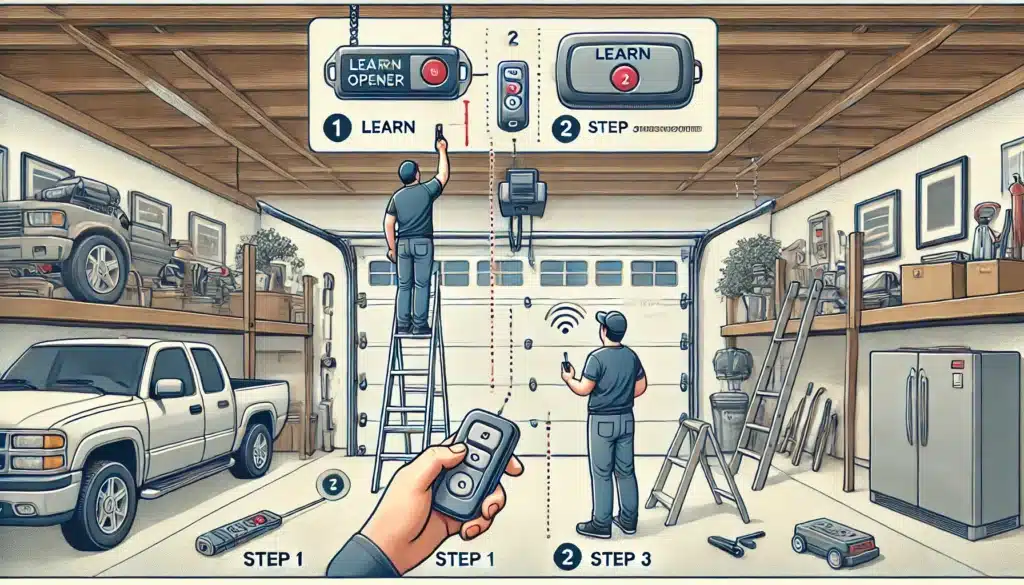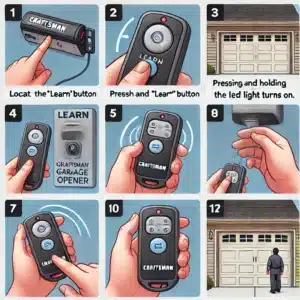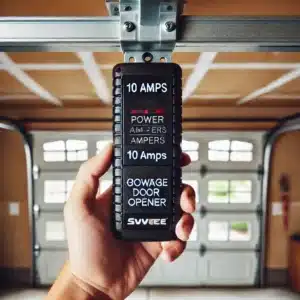Imagine coming home after a long day and effortlessly opening your garage door with the touch of a button. A properly programmed garage door opener remote not only adds convenience to your daily routine but also enhances the security of your home. No more getting out of your car in bad weather or fumbling with keys in the dark. The remote does all the work, offering a seamless entry experience.
If you’re wondering how to program your garage door opener remote, you’ve come to the right place. Whether you’re setting up a new remote or reprogramming an existing one, this guide will provide clear, step-by-step instructions to make the process easy and quick. We’ll walk you through everything you need to know, from understanding your specific remote model to troubleshooting common issues.
Programming your remote may seem daunting, but with our straightforward guide, you’ll have it up and running in no time. So, let’s dive in and get your garage door opener remote programmed, ensuring you can enjoy the full benefits of its convenience and security. Read on to discover just how simple this process can be!

Understanding Your Garage Door Opener Remote
What is a Garage Door Opener Remote?
A garage door opener remote is a handheld device that allows you to control your garage door opener from a distance. By pressing a button on the remote, you send a signal to the garage door opener motor, which then activates to either open or close the garage door. This small yet powerful device can make a significant difference in your daily routine by saving time and effort.
The importance of programming your garage door opener remote correctly cannot be overstated. Proper programming ensures that only your remote can operate your garage door, providing a layer of security against unauthorized access. Additionally, a correctly programmed remote ensures reliable operation, reducing the chances of frustrating glitches or malfunctions.
Types of Garage Door Opener Remotes
When it comes to garage door opener remotes, there are two main types: fixed code remotes and rolling code remotes. Understanding the difference between these types is crucial for ensuring the security and compatibility of your remote with your garage door opener system.
- Fixed Code Remotes:
- Explanation: Fixed code remotes transmit the same code every time you press the button. This code is manually set on both the remote and the garage door opener using a series of switches known as DIP switches.
- Pros: These remotes are generally simpler and more straightforward to program.
- Cons: Because the code is always the same, fixed code remotes are less secure. If someone were to intercept the signal, they could potentially gain access to your garage.
- Explanation: Fixed code remotes transmit the same code every time you press the button. This code is manually set on both the remote and the garage door opener using a series of switches known as DIP switches.
- Rolling Code Remotes:
- Explanation: Rolling code remotes, also known as “hopping code” remotes, generate a new code every time you use them. The garage door opener and the remote share a synchronized algorithm that ensures the codes match each time.
- Pros: These remotes are much more secure because the code changes with each use, making it extremely difficult for someone to intercept and use the signal.
- Cons: Rolling code remotes can be slightly more complicated to program due to the advanced technology involved.
- Explanation: Rolling code remotes, also known as “hopping code” remotes, generate a new code every time you use them. The garage door opener and the remote share a synchronized algorithm that ensures the codes match each time.
Popular Brands and Compatibility Considerations
There are several popular brands of garage door opener remotes, each offering various models with different features. Some of the most well-known brands include LiftMaster, Chamberlain, Genie, and Craftsman. When selecting a remote, it’s important to ensure compatibility with your garage door opener system. Here are a few tips to keep in mind:
- Check the Manufacturer: Ensure the remote is made by the same manufacturer as your garage door opener. Many manufacturers produce remotes specifically designed to work with their openers.
- Universal Remotes: Some remotes are designed to be universal and can work with multiple brands and models. However, it’s crucial to verify compatibility before purchasing.
- Frequency and Technology: Verify that the remote uses the same frequency and technology (fixed code or rolling code) as your garage door opener. This information can typically be found in the user manual or on the manufacturer’s website.
By understanding the different types of garage door opener remotes and the importance of proper programming, you’ll be better equipped to choose the right remote for your needs and ensure it functions smoothly with your garage door opener system. Up next, we’ll walk you through the preparation steps needed to get started with programming your remote.
Preparation
Tools and Materials Needed
Before you begin programming your garage door opener remote, it’s essential to gather all the necessary tools and materials. Having everything on hand will make the process smoother and more efficient. Here’s what you’ll need:
- Ladder: A sturdy ladder is crucial for reaching the garage door opener motor, usually mounted on the ceiling of your garage.
- Instruction Manual: The manual for your garage door opener will provide specific information about your model and may contain vital programming instructions.
- New Battery: If your remote hasn’t been used in a while or if you’re unsure of its battery status, it’s a good idea to have a fresh battery on hand. Most remotes use a standard coin cell battery.
- Small Screwdriver: Some remotes require a screwdriver to open the battery compartment or access the DIP switches (for fixed code remotes).
Having these tools ready will ensure you’re well-prepared to start the programming process without any interruptions.
Safety Precautions
Safety should always be your top priority when working with electrical devices and equipment. Follow these safety precautions to ensure a safe programming experience:
- Ensure the Garage Door is Closed: Before you start, make sure the garage door is fully closed. This prevents any accidents or injuries from the door moving unexpectedly during the programming process.
- Disconnect the Power Source: Unplug the garage door opener from the power outlet to prevent any electrical hazards. This step is especially important if your garage door opener has exposed electrical components.
- Use a Stable Ladder: When using a ladder to reach the garage door opener motor, ensure it is stable and placed on a flat surface. Avoid standing on the top rung, and always follow ladder safety guidelines.
- Keep Your Work Area Clear: Remove any obstacles or clutter around your work area to prevent trips and falls. Ensure you have a clear path to move the ladder and access the garage door opener motor.
By gathering the necessary tools and materials and following these safety precautions, you’ll be well-prepared to start programming your garage door opener remote safely and efficiently. Next, we’ll dive into the step-by-step guide to help you program your remote with ease.

Step-by-Step Guide
Step 1: Locate the Learn Button
The first step in programming your garage door opener remote is to locate the learn button on your garage door opener motor. The learn button is usually found on the back or side of the motor unit and may be labeled as “Learn,” “Set,” or “Program.” Here’s how to find it on different models:
- LiftMaster and Chamberlain: The learn button is typically located near the antenna wire that hangs from the motor. It may be yellow, red, orange, or purple.
- Genie: The learn button can often be found behind the light lens cover on the motor head. You might need to remove the cover to access it.
- Craftsman: Similar to LiftMaster and Chamberlain, the learn button is usually near the antenna wire and may be labeled “Learn” or “SRT.”
Using a ladder will make it easier to reach the learn button if it’s mounted high on the ceiling. Check your garage door opener’s manual for specific details on the location of the learn button for your model.
Step 2: Press and Release the Learn Button
Once you’ve located the learn button, the next step is to press and release it. Here’s what you need to do:
- Press and Release: Quickly press the learn button and release it. Do not hold it down for too long, as this may reset the entire system.
- Indicator Light: After pressing the learn button, you should see an indicator light start to blink. This light typically blinks for about 30 seconds, indicating that the opener is in programming mode and ready to accept a new remote signal.
Step 3: Program the Remote
With the garage door opener in programming mode, it’s time to program the remote. Follow these instructions:
- Press the Remote Button: Within the 30-second window of the indicator light blinking, press and hold the button on the remote that you wish to program.
- Hold Until Confirmation: Continue holding the remote button until you see the indicator light on the garage door opener motor blink or hear a click. This usually takes a few seconds and indicates that the remote has successfully paired with the opener.
Troubleshooting Tips:
- If the remote doesn’t pair on the first try, ensure you press the remote button within the 30-second window and try again.
- Make sure the remote has a fresh battery installed to avoid signal issues.
Step 4: Test the Remote
Now that you’ve programmed the remote, it’s time to test it to ensure everything works correctly:
- Reconnect the Power Source: Plug the garage door opener back into the power outlet if you disconnected it during the safety precautions.
- Test the Remote: Stand a few feet away from the garage door and press the button on the remote. The garage door should respond by opening or closing.
- Additional Troubleshooting: If the garage door doesn’t respond, repeat the programming steps, making sure you follow each step carefully. Check the remote’s battery and ensure there are no obstructions or interference between the remote and the opener.
By following these steps, you should have successfully programmed your garage door opener remote. If you encounter any issues, refer to the troubleshooting section of your garage door opener’s manual or seek assistance from the manufacturer’s customer support. With your remote program, you can now enjoy the convenience and security of easy access to your garage.
Advanced Tips and Troubleshooting
Once you’ve successfully programmed your garage door opener remote, there are additional tips and troubleshooting steps you can take to enhance your experience and address common issues.
Programming Multiple Remotes
If you have multiple vehicles or family members who need access to the garage, you can easily program additional remotes to work with your garage door opener. Here’s how to add more remotes:
- Access Programming Mode: Repeat Steps 1 and 2 from the Step-by-Step Guide to access the programming mode on your garage door opener.
- Program Each Remote: After the indicator light on the motor starts blinking, press and hold the button on the new remote you want to program. Hold until the motor’s indicator light blinks again or you hear a click, indicating successful programming.
- Test Each Remote: After programming each remote, test them individually to ensure they open and close the garage door correctly. Stand at different distances and angles to ensure reliable operation.
Resetting the Garage Door Opener System
If you encounter issues with your garage door opener or need to start over with programming, resetting the system can often resolve problems. Here’s how to reset your garage door opener:
- Locate the Reset Button: The reset button is typically located on the back of the motor unit near the learn button. It may be a small, recessed button that requires a paperclip or similar tool to press.
- Press and Hold the Reset Button: Use a tool to press and hold the reset button for about 10-15 seconds. Release the button when the indicator light on the motor blinks, indicating that the system has been reset.
- Reprogram Remotes: After resetting, you’ll need to reprogram your remotes using the steps outlined in the Step-by-Step Guide.
Common Problems and Solutions
Even with proper programming, you may encounter common issues with your garage door opener remote. Here are some troubleshooting tips:
- Signal Interference:
- Problem: Interference from other electronic devices or nearby sources can disrupt the signal between your remote and the garage door opener.
- Solution: Move any potential sources of interference away from the garage door opener. Ensure there are no large metal objects or electronic devices operating on the same frequency nearby.
- Problem: Interference from other electronic devices or nearby sources can disrupt the signal between your remote and the garage door opener.
- Battery Issues:
- Problem: A weak or dead battery in the remote can cause intermittent signal transmission or failure to operate.
- Solution: Replace the battery with a new one according to the manufacturer’s specifications. Ensure the battery contacts are clean and free from corrosion.
- Problem: A weak or dead battery in the remote can cause intermittent signal transmission or failure to operate.
- Range Limitations:
- Problem: Your remote may not operate reliably from certain distances or angles.
- Solution: Check the manufacturer’s guidelines for the optimal operating range of your remote. If necessary, reposition the antenna on the motor unit to improve signal reception.
- Problem: Your remote may not operate reliably from certain distances or angles.
By following these advanced tips and troubleshooting steps, you can ensure your garage door opener remote operates smoothly and efficiently. If you continue to experience problems, refer to your garage door opener’s user manual for more detailed troubleshooting instructions or contact customer support for assistance. With proper maintenance and occasional troubleshooting, your garage door opener remote will continue to provide convenient access to your garage for years to come.
Maintenance and Security
Maintaining your garage door opener system not only ensures its longevity but also enhances its security features. Here’s how you can keep your system in optimal condition and protect your home.
Regular Maintenance
To keep your garage door opener system running smoothly, regular maintenance is crucial. Follow these tips:
- Lubrication: Periodically lubricate moving parts such as rollers, hinges, and springs with a silicone-based lubricant to reduce friction and wear.
- Visual Inspection: Inspect the garage door and opener system for signs of wear or damage to cables, springs, and tracks. Address issues promptly to prevent further damage.
- Tighten Hardware: Check and tighten any loose bolts or screws on the garage door and opener system. Regular use can cause hardware to loosen over time.
- Test Safety Features: Test the auto-reverse mechanism by placing an object in the door’s path; it should reverse immediately upon contact.
- Clean Sensors: Keep the sensors at the bottom of the garage door clean and free from debris. Misaligned or dirty sensors can prevent proper door operation.
Security Best Practices
Enhance the security of your garage door opener system to protect against unauthorized access:
- Secure Remote: Treat your garage door opener remote like a key. Keep it in a secure location, such as inside your house or a locked vehicle, and avoid leaving it in plain sight.
- Use a Keychain Remote: Consider a keychain remote for easy accessibility while minimizing the risk of loss or theft.
- Update Access Codes: Regularly update the access codes. Change codes periodically to prevent unauthorized access, especially if you suspect a compromise.
- Disable Lost Remotes: If you lose a remote or suspect it’s stolen, disable it immediately. Refer to your manual for instructions on erasing the remote’s code.
- Install a Security System: Integrate your garage door opener with a home security system for monitoring and alerts on unauthorized access attempts.
- Educate Family Members: Ensure all family members understand garage door security, know how to use the remote responsibly and keep it secure.
By following these maintenance and security best practices, you ensure your garage door opener system and garage door repair remain reliable and secure. Regular maintenance extends the system’s lifespan and enhances safety, providing peace of mind for you and your family. Take proactive steps to protect your home from potential security threats associated with garage door opener systems.

Frequently Asked Questions
Here are answers to common questions about programming and maintaining your garage door opener remote:
How do I find the learn button on my garage door opener?
The learn button is usually located on the back or side of the motor unit, near the antenna wire, or under a light cover. It may be labeled “Learn,” “Set,” or similar and often has a distinctive color.
What if my remote doesn’t work after programming?
Ensure you followed the programming steps correctly. Check the remote’s battery and look for any signal interference. If issues persist, consult your opener’s manual or contact customer support.
Can I program more than one remote to my garage door opener? Yes, you can program multiple remotes. Repeat the programming steps for each additional remote. Each remote will operate independently.
How often should I update my garage door opener code? Update your code periodically for security. This is crucial if you’ve lost a remote or moved to a new home. Regular updates enhance your garage’s security.
What if I accidentally reset my garage door opener? Resetting the opener clears all codes. Reprogram all remotes and keypads following the manual’s steps to restore functionality.
Conclusion
Programming your garage door opener remote is a straightforward process that enhances your home’s convenience and security. By following the steps in this guide, you can manage garage access effortlessly, ensuring seamless entry and exit. Proper programming saves time and adds a layer of security to prevent unauthorized access.
Whether you’re setting up a new remote or reprogramming an existing one, the provided steps offer a clear path to success. Maintaining your new garage door opener system and periodically updating access codes are essential for long-term reliability and safety.
Ready to program your remote? Follow our detailed guide to ensure your home’s security and convenience. Proper programming invests in the safety and ease of garage access, making daily routines smoother. For further assistance, consult your garage door opener’s manual or customer support.






